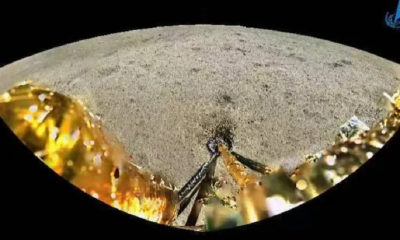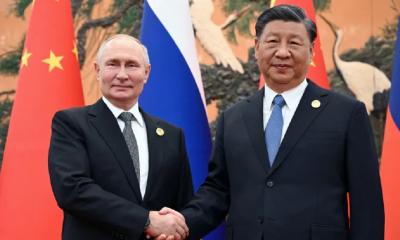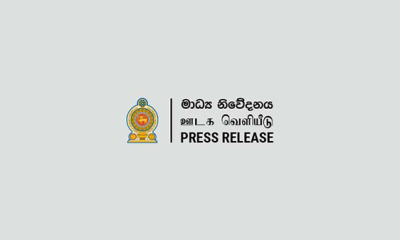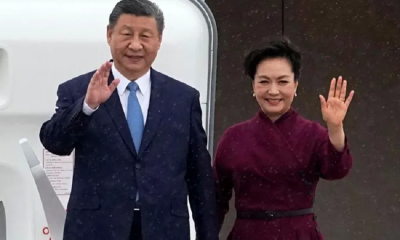Features
What Swirls Beneath Research Activity of Chinese Ships in the Indian Ocean?
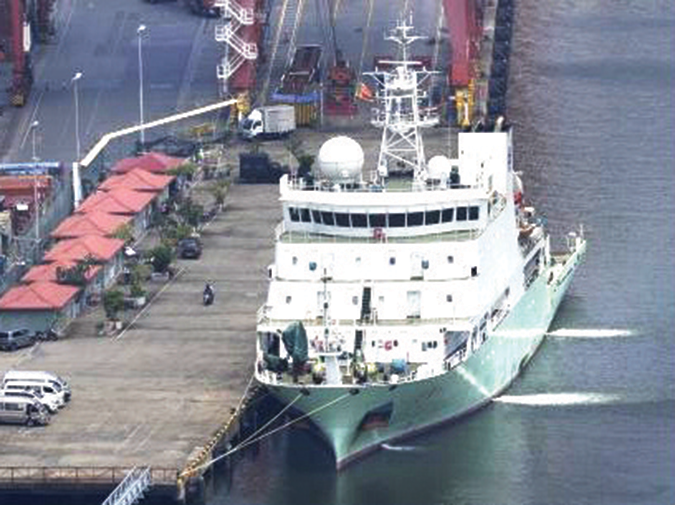
Collection of oceanic data will provide China with information about seabed resources and also help it prepare for submarine warfare.
by Rathindra Kuruwita
On October 31, Sri Lankan and Chinese researchers on board the Chinese research vessel Shi Yan 6, which recently docked at Colombo port in Sri Lanka, began two days of “marine scientific” research off the Sri Lankan coast.
The docking of the Shi Yan 6 a few days earlier had stirred strong responses from India and the United States. The same thing happened last year when another Chinese ship, the Yuan Wang 5, had docked at Sri Lanka’s Hambantota port.
Sri Lankan Foreign Minister Mohamed Ali Sabry acknowledged that the Sri Lankan government had come under pressure from India and other parties to halt the arrival of the Chinese research vessel. He emphasized the complexity of the situation due to geopolitics and the need to be prepared to handle these pressures while maintaining good relations with all involved parties.
Over the past 15 years, several Chinese research vessels and warships have visited Sri Lankan ports with limited media attention. It is only over the last couple of years that Chinese vessels arriving in Sri Lanka have received heightened scrutiny.
According to Dr. Nilanthi Samaranayake, a visiting expert at the United States Institute of Peace, the ongoing border conflict between China and India since 2020 has increased New Delhi’s concerns about China’s presence in the Indian Ocean. Recent visits of Chinese vessels to Lankan ports have garnered more attention, as they are closely monitored by the Indian Navy.
“The Chinese ships that have visited over the past year are different types with different missions and are closely tracked by the Indian Navy. The persistent border conflict between China and India since 2020 has elevated New Delhi’s threat perceptions of China’s presence in the Indian Ocean. This factor, combined with greater access to ship tracking data, has resulted in a situation where every visiting Chinese ship is likely to receive media attention for the foreseeable future,” Samaranayake said.
For most of the 20th century, the Indian Ocean has, at most, held secondary importance in the strategic considerations of Chinese leaders. China did assign a certain level of importance to India, primarily due to the longstanding border dispute that led to a short but significant war in 1962, India’s development of long-range missiles, and its acquisition of nuclear capabilities. For a long time, China lacked the naval capacity to project power in the Indian Ocean Region (IOR) and had not clearly articulated such ambitions in its public strategic documents. Additionally, the necessary military assets were not readily available.
However, significant changes have taken place in recent decades.
Increasing Chinese engagement in the IOR has raised fears among American and Indian strategists that China’s growing naval presence, together with control of strategically located ports in the region, might provide Beijing with significant military advantages far from its shores.
Indian observers are nervously eyeing China’s increasingly sophisticated military capabilities and noted its gradually expanding mission sets that extend beyond the waters of the western Pacific. American strategists, increasingly focused on a multifront competition with a rising China, are warning the world about China’s so-called debt-trap diplomacy. Both India and the United States insist that small countries within the region will not be able to navigate China’s political influence while retaining their freedom of maneuver.
From Indian and U.S. perspectives, these concerns are entirely reasonable. International relations scholars from the realist school had long predicted that India would be an important pillar in the balancing coalition that the United States would try to establish to contain China. And yet, most conclusions are derived not from present-day assessments of China’s influence, access, or capabilities in the region — all of which remain modest — but from future projections of its role in the wider IOR.
According to a 2020 Brookings Institution report, there are five “meta-mission objectives” that the People’s Liberation Army (PLA) might pursue in principle, and to varying degrees is already pursuing, roughly ordered from those that are the most notionally non-threatening to those that are the most ambitious and potentially troubling to the United States, and to its close partners in the region such as India.
They are: 1) conducting non-combat activities focused on protecting Chinese citizens and investments, and bolstering China’s soft power influence; 2) undertaking counterterrorism activities, unilaterally or with partners, against organizations that threaten China; 3) collecting intelligence in support of operational requirements, and against key adversaries; 4) supporting efforts aimed at coercive diplomacy toward small countries in the region; and 5) enabling effective operations in a conflict environment, namely the ability to deter, mitigate, or terminate a state-sponsored interdiction of trade bound for China, and to meaningfully hold at risk U.S. or Indian assets in the event of a wider conflict.
Of these, the third meta-mission objective seems to have caught the imagination of policymakers, strategists, and media outlets. Researchers affiliated with U.S. defense institutions have been raising concerns, dating back at least to 2017, regarding the potential significant implications of these vessels for U.S. national security.
In a 2018 report authored by Ryan D. Martinson and Peter A. Dutton of the U.S. Naval War College, it was noted that approximately 5 to 10 Chinese scientific research vessels were operating outside of Chinese jurisdictional waters, particularly in areas of the Indo-Pacific deemed strategically important. The authors also highlighted that most of the Chinese research vessels commissioned since 2012 are multifunctional research platforms equipped to conduct a wide array of research activities. These vessels primarily serve as hosts for various instruments, sensors, and equipment used for the collection of oceanic and atmospheric data.
The authors claim that certain sensors are affixed to these research vessels. For instance, many of these ships feature “science masts” at the bow, designed for the collection of meteorological data. Additionally, all these vessels are equipped with various sensors attached to their hulls. More modern vessels, such as the Kexue, are outfitted with “gondolas,” retractable structures located beneath the ship to prevent the interference of bubbles with data measurements.
Acoustic Doppler Current Profilers (ADCPs) are employed to send sound waves into the water column, with the returning echoes providing information about the direction and speed of undersea currents. Multi-beam echo sounders utilize sound pulses to achieve precise measurements of ocean depth, which can then be used to ascertain the contours, or bathymetry, of the seabed.
Some of these sensors are towed behind the ship. For example, the Chinese Academy of Science (CAS) research vessel Shiyan 1 boasts a twin-hull (SWATH) design, ensuring improved stability when towing its acoustic array. Several of these vessels can tow streamers utilized for seismic surveys, directing sound waves into the seabed. The strength and pattern of the echoes that return are then used to determine the geological composition of the subsoil, including the potential presence of oil and gas deposits.
China’s deployment of oceanographic research ships and related platforms in distant ocean areas is part of a massive program to collect oceanic data. What is the ultimate purpose of this collection effort?
Asanga Abeyagoonasekera, a senior fellow at The Millennium Project in the United States, told The Diplomat that the Shi Yan 6 research vessel specializes in geophysical exploration, a capability that holds potential implications for submarine warfare.
Abeyagoonasekera raised two primary concerns: First, the apprehension that China could access critical data regarding seabed resources in the Indian Ocean, particularly in the context of intensified global competition for minerals and energy resources. Second, he highlighted the collection of ocean and seabed data by vessels like the Shi Yan 6, which could be used in the future for strategic naval planning, especially relating to submarine warfare.
These concerns are amplified by the perception that Sri Lankan President Ranil Wickremesinghe, once seen as a friend of India and the West, has moved closer to China, as evident in recent agreements such as the one with Huawei to digitize Sri Lankan schools, a deal that was rejected during Maithripala Sirisena’s presidency.
This shift in Sri Lanka’s foreign policy is causing concern in India, Abeyagoonasekera pointed out.
Although the era of unipolarity has passed, the nature of the international system dictates that the United States will not relinquish its dominant position in Asia without contesting China, the rising power. It has formed the Quad alliance to counter China.
From the realist lens, Sri Lanka’s reassurances may not fully alleviate the suspicions harbored by the containment alliance regarding the country’s relationship with China. However, by conducting its activities with China in a more transparent manner, Sri Lanka can potentially persuade at least some sections of the containment alliance that its ties with China do not pose an immediate threat.
Samaranayake suggests that given its strategic location along the sea lanes of the Indian Ocean and its historical practice of allowing ship visits from extra-regional powers, Sri Lanka should promptly disclose the extensively discussed Standard Operating Procedure for foreign vessels entering Sri Lankan waters.
Features
The heart-friendly health minister

by Dr Gotabhya Ranasinghe
Senior Consultant Cardiologist
National Hospital Sri Lanka
When we sought a meeting with Hon Dr. Ramesh Pathirana, Minister of Health, he graciously cleared his busy schedule to accommodate us. Renowned for his attentive listening and deep understanding, Minister Pathirana is dedicated to advancing the health sector. His openness and transparency exemplify the qualities of an exemplary politician and minister.
Dr. Palitha Mahipala, the current Health Secretary, demonstrates both commendable enthusiasm and unwavering support. This combination of attributes makes him a highly compatible colleague for the esteemed Minister of Health.
Our discussion centered on a project that has been in the works for the past 30 years, one that no other minister had managed to advance.
Minister Pathirana, however, recognized the project’s significance and its potential to revolutionize care for heart patients.
The project involves the construction of a state-of-the-art facility at the premises of the National Hospital Colombo. The project’s location within the premises of the National Hospital underscores its importance and relevance to the healthcare infrastructure of the nation.
This facility will include a cardiology building and a tertiary care center, equipped with the latest technology to handle and treat all types of heart-related conditions and surgeries.
Securing funding was a major milestone for this initiative. Minister Pathirana successfully obtained approval for a $40 billion loan from the Asian Development Bank. With the funding in place, the foundation stone is scheduled to be laid in September this year, and construction will begin in January 2025.
This project guarantees a consistent and uninterrupted supply of stents and related medications for heart patients. As a result, patients will have timely access to essential medical supplies during their treatment and recovery. By securing these critical resources, the project aims to enhance patient outcomes, minimize treatment delays, and maintain the highest standards of cardiac care.
Upon its fruition, this monumental building will serve as a beacon of hope and healing, symbolizing the unwavering dedication to improving patient outcomes and fostering a healthier society.We anticipate a future marked by significant progress and positive outcomes in Sri Lanka’s cardiovascular treatment landscape within the foreseeable timeframe.
Features
A LOVING TRIBUTE TO JESUIT FR. ALOYSIUS PIERIS ON HIS 90th BIRTHDAY

by Fr. Emmanuel Fernando, OMI
Jesuit Fr. Aloysius Pieris (affectionately called Fr. Aloy) celebrated his 90th birthday on April 9, 2024 and I, as the editor of our Oblate Journal, THE MISSIONARY OBLATE had gone to press by that time. Immediately I decided to publish an article, appreciating the untiring selfless services he continues to offer for inter-Faith dialogue, the renewal of the Catholic Church, his concern for the poor and the suffering Sri Lankan masses and to me, the present writer.
It was in 1988, when I was appointed Director of the Oblate Scholastics at Ampitiya by the then Oblate Provincial Fr. Anselm Silva, that I came to know Fr. Aloy more closely. Knowing well his expertise in matters spiritual, theological, Indological and pastoral, and with the collaborative spirit of my companion-formators, our Oblate Scholastics were sent to Tulana, the Research and Encounter Centre, Kelaniya, of which he is the Founder-Director, for ‘exposure-programmes’ on matters spiritual, biblical, theological and pastoral. Some of these dimensions according to my view and that of my companion-formators, were not available at the National Seminary, Ampitiya.
Ever since that time, our Oblate formators/ accompaniers at the Oblate Scholasticate, Ampitiya , have continued to send our Oblate Scholastics to Tulana Centre for deepening their insights and convictions regarding matters needed to serve the people in today’s context. Fr. Aloy also had tried very enthusiastically with the Oblate team headed by Frs. Oswald Firth and Clement Waidyasekara to begin a Theologate, directed by the Religious Congregations in Sri Lanka, for the contextual formation/ accompaniment of their members. It should very well be a desired goal of the Leaders / Provincials of the Religious Congregations.
Besides being a formator/accompanier at the Oblate Scholasticate, I was entrusted also with the task of editing and publishing our Oblate journal, ‘The Missionary Oblate’. To maintain the quality of the journal I continue to depend on Fr. Aloy for his thought-provoking and stimulating articles on Biblical Spirituality, Biblical Theology and Ecclesiology. I am very grateful to him for his generous assistance. Of late, his writings on renewal of the Church, initiated by Pope St. John XX111 and continued by Pope Francis through the Synodal path, published in our Oblate journal, enable our readers to focus their attention also on the needed renewal in the Catholic Church in Sri Lanka. Fr. Aloy appreciated very much the Synodal path adopted by the Jesuit Pope Francis for the renewal of the Church, rooted very much on prayerful discernment. In my Religious and presbyteral life, Fr.Aloy continues to be my spiritual animator / guide and ongoing formator / acccompanier.
Fr. Aloysius Pieris, BA Hons (Lond), LPh (SHC, India), STL (PFT, Naples), PhD (SLU/VC), ThD (Tilburg), D.Ltt (KU), has been one of the eminent Asian theologians well recognized internationally and one who has lectured and held visiting chairs in many universities both in the West and in the East. Many members of Religious Congregations from Asian countries have benefited from his lectures and guidance in the East Asian Pastoral Institute (EAPI) in Manila, Philippines. He had been a Theologian consulted by the Federation of Asian Bishops’ Conferences for many years. During his professorship at the Gregorian University in Rome, he was called to be a member of a special group of advisers on other religions consulted by Pope Paul VI.
Fr. Aloy is the author of more than 30 books and well over 500 Research Papers. Some of his books and articles have been translated and published in several countries. Among those books, one can find the following: 1) The Genesis of an Asian Theology of Liberation (An Autobiographical Excursus on the Art of Theologising in Asia, 2) An Asian Theology of Liberation, 3) Providential Timeliness of Vatican 11 (a long-overdue halt to a scandalous millennium, 4) Give Vatican 11 a chance, 5) Leadership in the Church, 6) Relishing our faith in working for justice (Themes for study and discussion), 7) A Message meant mainly, not exclusively for Jesuits (Background information necessary for helping Francis renew the Church), 8) Lent in Lanka (Reflections and Resolutions, 9) Love meets wisdom (A Christian Experience of Buddhism, 10) Fire and Water 11) God’s Reign for God’s poor, 12) Our Unhiddden Agenda (How we Jesuits work, pray and form our men). He is also the Editor of two journals, Vagdevi, Journal of Religious Reflection and Dialogue, New Series.
Fr. Aloy has a BA in Pali and Sanskrit from the University of London and a Ph.D in Buddhist Philosophy from the University of Sri Lankan, Vidyodaya Campus. On Nov. 23, 2019, he was awarded the prestigious honorary Doctorate of Literature (D.Litt) by the Chancellor of the University of Kelaniya, the Most Venerable Welamitiyawe Dharmakirthi Sri Kusala Dhamma Thera.
Fr. Aloy continues to be a promoter of Gospel values and virtues. Justice as a constitutive dimension of love and social concern for the downtrodden masses are very much noted in his life and work. He had very much appreciated the commitment of the late Fr. Joseph (Joe) Fernando, the National Director of the Social and Economic Centre (SEDEC) for the poor.
In Sri Lanka, a few religious Congregations – the Good Shepherd Sisters, the Christian Brothers, the Marist Brothers and the Oblates – have invited him to animate their members especially during their Provincial Congresses, Chapters and International Conferences. The mainline Christian Churches also have sought his advice and followed his seminars. I, for one, regret very much, that the Sri Lankan authorities of the Catholic Church –today’s Hierarchy—- have not sought Fr.
Aloy’s expertise for the renewal of the Catholic Church in Sri Lanka and thus have not benefited from the immense store of wisdom and insight that he can offer to our local Church while the Sri Lankan bishops who governed the Catholic church in the immediate aftermath of the Second Vatican Council (Edmund Fernando OMI, Anthony de Saram, Leo Nanayakkara OSB, Frank Marcus Fernando, Paul Perera,) visited him and consulted him on many matters. Among the Tamil Bishops, Bishop Rayappu Joseph was keeping close contact with him and Bishop J. Deogupillai hosted him and his team visiting him after the horrible Black July massacre of Tamils.
Features
A fairy tale, success or debacle

Sri Lanka-Singapore Free Trade Agreement
By Gomi Senadhira
senadhiragomi@gmail.com
“You might tell fairy tales, but the progress of a country cannot be achieved through such narratives. A country cannot be developed by making false promises. The country moved backward because of the electoral promises made by political parties throughout time. We have witnessed that the ultimate result of this is the country becoming bankrupt. Unfortunately, many segments of the population have not come to realize this yet.” – President Ranil Wickremesinghe, 2024 Budget speech
Any Sri Lankan would agree with the above words of President Wickremesinghe on the false promises our politicians and officials make and the fairy tales they narrate which bankrupted this country. So, to understand this, let’s look at one such fairy tale with lots of false promises; Ranil Wickremesinghe’s greatest achievement in the area of international trade and investment promotion during the Yahapalana period, Sri Lanka-Singapore Free Trade Agreement (SLSFTA).
It is appropriate and timely to do it now as Finance Minister Wickremesinghe has just presented to parliament a bill on the National Policy on Economic Transformation which includes the establishment of an Office for International Trade and the Sri Lanka Institute of Economics and International Trade.
Was SLSFTA a “Cleverly negotiated Free Trade Agreement” as stated by the (former) Minister of Development Strategies and International Trade Malik Samarawickrama during the Parliamentary Debate on the SLSFTA in July 2018, or a colossal blunder covered up with lies, false promises, and fairy tales? After SLSFTA was signed there were a number of fairy tales published on this agreement by the Ministry of Development Strategies and International, Institute of Policy Studies, and others.
However, for this article, I would like to limit my comments to the speech by Minister Samarawickrama during the Parliamentary Debate, and the two most important areas in the agreement which were covered up with lies, fairy tales, and false promises, namely: revenue loss for Sri Lanka and Investment from Singapore. On the other important area, “Waste products dumping” I do not want to comment here as I have written extensively on the issue.
1. The revenue loss
During the Parliamentary Debate in July 2018, Minister Samarawickrama stated “…. let me reiterate that this FTA with Singapore has been very cleverly negotiated by us…. The liberalisation programme under this FTA has been carefully designed to have the least impact on domestic industry and revenue collection. We have included all revenue sensitive items in the negative list of items which will not be subject to removal of tariff. Therefore, 97.8% revenue from Customs duty is protected. Our tariff liberalisation will take place over a period of 12-15 years! In fact, the revenue earned through tariffs on goods imported from Singapore last year was Rs. 35 billion.
The revenue loss for over the next 15 years due to the FTA is only Rs. 733 million– which when annualised, on average, is just Rs. 51 million. That is just 0.14% per year! So anyone who claims the Singapore FTA causes revenue loss to the Government cannot do basic arithmetic! Mr. Speaker, in conclusion, I call on my fellow members of this House – don’t mislead the public with baseless criticism that is not grounded in facts. Don’t look at petty politics and use these issues for your own political survival.”
I was surprised to read the minister’s speech because an article published in January 2018 in “The Straits Times“, based on information released by the Singaporean Negotiators stated, “…. With the FTA, tariff savings for Singapore exports are estimated to hit $10 million annually“.
As the annual tariff savings (that is the revenue loss for Sri Lanka) calculated by the Singaporean Negotiators, Singaporean $ 10 million (Sri Lankan rupees 1,200 million in 2018) was way above the rupees’ 733 million revenue loss for 15 years estimated by the Sri Lankan negotiators, it was clear to any observer that one of the parties to the agreement had not done the basic arithmetic!
Six years later, according to a report published by “The Morning” newspaper, speaking at the Committee on Public Finance (COPF) on 7th May 2024, Mr Samarawickrama’s chief trade negotiator K.J. Weerasinghehad had admitted “…. that forecasted revenue loss for the Government of Sri Lanka through the Singapore FTA is Rs. 450 million in 2023 and Rs. 1.3 billion in 2024.”
If these numbers are correct, as tariff liberalisation under the SLSFTA has just started, we will pass Rs 2 billion very soon. Then, the question is how Sri Lanka’s trade negotiators made such a colossal blunder. Didn’t they do their basic arithmetic? If they didn’t know how to do basic arithmetic they should have at least done their basic readings. For example, the headline of the article published in The Straits Times in January 2018 was “Singapore, Sri Lanka sign FTA, annual savings of $10m expected”.
Anyway, as Sri Lanka’s chief negotiator reiterated at the COPF meeting that “…. since 99% of the tariffs in Singapore have zero rates of duty, Sri Lanka has agreed on 80% tariff liberalisation over a period of 15 years while expecting Singapore investments to address the imbalance in trade,” let’s turn towards investment.
Investment from Singapore
In July 2018, speaking during the Parliamentary Debate on the FTA this is what Minister Malik Samarawickrama stated on investment from Singapore, “Already, thanks to this FTA, in just the past two-and-a-half months since the agreement came into effect we have received a proposal from Singapore for investment amounting to $ 14.8 billion in an oil refinery for export of petroleum products. In addition, we have proposals for a steel manufacturing plant for exports ($ 1 billion investment), flour milling plant ($ 50 million), sugar refinery ($ 200 million). This adds up to more than $ 16.05 billion in the pipeline on these projects alone.
And all of these projects will create thousands of more jobs for our people. In principle approval has already been granted by the BOI and the investors are awaiting the release of land the environmental approvals to commence the project.
I request the Opposition and those with vested interests to change their narrow-minded thinking and join us to develop our country. We must always look at what is best for the whole community, not just the few who may oppose. We owe it to our people to courageously take decisions that will change their lives for the better.”
According to the media report I quoted earlier, speaking at the Committee on Public Finance (COPF) Chief Negotiator Weerasinghe has admitted that Sri Lanka was not happy with overall Singapore investments that have come in the past few years in return for the trade liberalisation under the Singapore-Sri Lanka Free Trade Agreement. He has added that between 2021 and 2023 the total investment from Singapore had been around $162 million!
What happened to those projects worth $16 billion negotiated, thanks to the SLSFTA, in just the two-and-a-half months after the agreement came into effect and approved by the BOI? I do not know about the steel manufacturing plant for exports ($ 1 billion investment), flour milling plant ($ 50 million) and sugar refinery ($ 200 million).
However, story of the multibillion-dollar investment in the Petroleum Refinery unfolded in a manner that would qualify it as the best fairy tale with false promises presented by our politicians and the officials, prior to 2019 elections.
Though many Sri Lankans got to know, through the media which repeatedly highlighted a plethora of issues surrounding the project and the questionable credentials of the Singaporean investor, the construction work on the Mirrijiwela Oil Refinery along with the cement factory began on the24th of March 2019 with a bang and Minister Ranil Wickremesinghe and his ministers along with the foreign and local dignitaries laid the foundation stones.
That was few months before the 2019 Presidential elections. Inaugurating the construction work Prime Minister Ranil Wickremesinghe said the projects will create thousands of job opportunities in the area and surrounding districts.
The oil refinery, which was to be built over 200 acres of land, with the capacity to refine 200,000 barrels of crude oil per day, was to generate US$7 billion of exports and create 1,500 direct and 3,000 indirect jobs. The construction of the refinery was to be completed in 44 months. Four years later, in August 2023 the Cabinet of Ministers approved the proposal presented by President Ranil Wickremesinghe to cancel the agreement with the investors of the refinery as the project has not been implemented! Can they explain to the country how much money was wasted to produce that fairy tale?
It is obvious that the President, ministers, and officials had made huge blunders and had deliberately misled the public and the parliament on the revenue loss and potential investment from SLSFTA with fairy tales and false promises.
As the president himself said, a country cannot be developed by making false promises or with fairy tales and these false promises and fairy tales had bankrupted the country. “Unfortunately, many segments of the population have not come to realize this yet”.
(The writer, a specialist and an activist on trade and development issues . )


